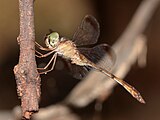Zyxomma elgneri
Appearance
| Short-tailed duskdarter | |
|---|---|

| |
| Male | |
| Scientific classification | |
| Domain: | Eukaryota |
| Kingdom: | Animalia |
| Phylum: | Arthropoda |
| Class: | Insecta |
| Order: | Odonata |
| Infraorder: | Anisoptera |
| Family: | Libellulidae |
| Genus: | Zyxomma |
| Species: | Z. elgneri
|
| Binomial name | |
| Zyxomma elgneri | |

| |
Zyxomma elgneri is a species of dragonfly in the family Libellulidae,[3][4] known as the short-tailed duskdarter.[5] It is a slender and short-bodied dragonfly with dull-coloured markings.[5] It inhabits a range of water sources including rivers, ponds and swamps in northern and eastern Australia,[6] and New Guinea.[7]
Gallery
[edit]-
Male lateral view
-
Female wings
-
Male wings
See also
[edit]References
[edit]Wikimedia Commons has media related to Zyxomma elgneri.
- ^ Dow, R.A. (2017). "Zyxomma elgneri". IUCN Red List of Threatened Species. 2017: e.T87535402A87540059. doi:10.2305/IUCN.UK.2017-1.RLTS.T87535402A87540059.en. Retrieved 20 November 2021.
- ^ Ris, F. (1913). "Libellulinen 7". Collections Zoologiques du Baron Edm. de Selys Longchamps (in German). Vol. 15. Brussels: Institut royal des Sciences naturelles de Belgique. pp. 837–964 [905]. doi:10.5962/bhl.title.9137 – via Biodiversity Heritage Library.
- ^ "Species Zyxomma elgneri Ris, 1913". Australian Faunal Directory. Australian Biological Resources Study. 2012. Retrieved 26 February 2017.
- ^ Schorr, Martin; Paulson, Dennis. "World Odonata List". Slater Museum of Natural History. University of Puget Sound. Retrieved 26 February 2017.
- ^ a b Theischinger, Günther; Hawking, John (2006). The Complete Field Guide to Dragonflies of Australia. Collingwood, Victoria, Australia: CSIRO Publishing. p. 290. ISBN 978 0 64309 073 6.
- ^ Theischinger, Gunther; Endersby, Ian (2009). Identification Guide to the Australian Odonata (PDF). Department of Environment, Climate Change and Water NSW. p. 241. ISBN 978 1 74232 475 3.
- ^ Watson, J.A.L.; Theischinger, G.; Abbey, H.M. (1991). The Australian Dragonflies: A Guide to the Identification, Distributions and Habitats of Australian Odonata. Melbourne: CSIRO. p. 278. ISBN 0643051368.




